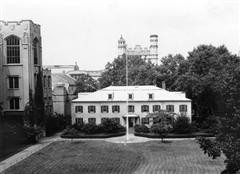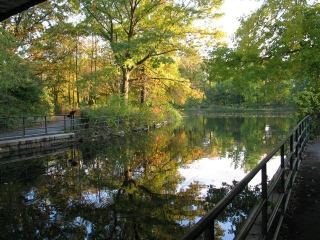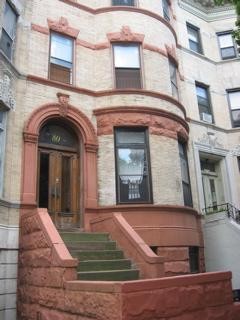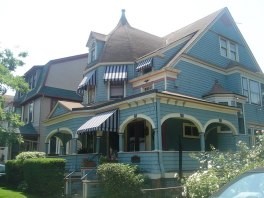Erasmus Hall High School
Class Of 1960
Flatbush and Erasmus History
|
History Of Flatbush And Erasmus Hall High School Susan Geller Rosefielde, Class of 1960 FLATBUSH, BROOKLYN When Henry Hudson sailed into New York Bay, in 1609, his first landing was at the western tip of Long Island. Though the captain was English, this sailing was under the auspices of the East India Company of Holland. The first European settlement, in 1624 was on Manhattan Island. That was quickly followed, in 1625, by a settlement of Dutch farmers at the west end of Long Island along the shoreline of Brooklyn. They purchased land from the Canarsee Indian owners and within a few years, 1630, acquired the first land grant on Long Island. After an initial attraction to the familiar lowlands, the settlers soon discovered that the densely wooded area north of their village had better farming conditions. Between 1630 and 1634 they moved their community to Midwout, and founded the first settlement in Flatbush, Vlacke bos, or flat woodland. In 1651 Governor Peter Stuyvesant chartered Flatbush as the Dutch Nieuw Nederland colony town of Midwout. Both names were used in the Dutch era, and Midwood was an alternative name for Flatbush into the early 20th century. Flatbush became the seat of Justice for the County of Long Island in the 17th century. A road was laid out along the old Indian path through the village of Flatbush Hills, becoming FLATBUSH AVENUE, and farm land was developed on both sides of the “Path”. “Old Town” Flatbush, and other towns of what was to become Kings County were surrendered to the English in 1664. Following the Revolutionary War, and the Battle of Prospect Hill, Flatbush grew slowly into a country town, with shaded streets, beautiful homes, schools, and churches. The influence of Dutch merchants and farming families remained strong in the area until the late 19th century. The community was cut off from the rest of Brooklyn by long stretches of open country, and by the hill running the entire length of the south side of Eastern Parkway. For many years Flatbush generally meant that section of Brooklyn running from Ocean Parkway to Schenectady Avenue, and from Prospect Park to Sheepshead Bay. Flatbush was incorporated into Brooklyn City in 1894. At that time, Flatbush described both the Town of Flatbush, a large area of central Kings County extending east to the Queens County border, and the Village of Flatbush, formerly the heart of the current community. Perhaps the greatest consideration in Brooklyn's residential development was the opening of the Brooklyn Bridge in 1883. It was the first bridge from Manhattan to Long Island. Horse drawn carriages, trolleys and the BMT line of trains allowed easy access to suburban Brooklyn. In 1898 Greater New York City was created by consolidating all of the boroughs and former independent towns. Flatbush developed as a suburb, around Prospect Park, the Brooklyn Museum of Art, and Botanic Gardens. It became an integral part of the larger city and shared train service with Manhattan and other neighborhoods. In the first half of the 20th century Flatbush had a sizable population of Irish-Americans, Italian-Americans and Jewish Americans. It was a combination of working class and middle class families, with a few affluent pockets of professionals. By the 1980’s many buildings were semi-abandoned and fell into disrepair. The community is now mostly working and lower income families from the West Indies, although there are still pockets of wealthier residents. ERASMUS HALL HIGH SCHOOL Erasmus Hall High School, originally called Erasmus Hall Academy was a private institution of higher learning founded in 1786 by Dutch clergymen, and Reverend John H. Livingston and Senator John Vanderbilt. Land was donated by the Flatbush Dutch Reformed Church and contributions were collected from leading citizens such as Aaron Burr, Alexander Hamilton, and Robert Livingston. Erasmus Hall was named for the Dutch Renaissance humanist scholar and theologian. A statue of Erasmus, cast from the 1622 original in Rotterdam, by Hendrick de Keiser, was given by an alumnus, Richard Young. It was dedicated in 1931 and the base is engraved with the following words: “Desiderius Erasmus, the maintainer and restorer of the sciences and polite literature, the greatest man of his century, the excellent citizen who, through his immortal writings, acquired an everlasting fame.” The clapboard Federal style building, constructed in 1787, opened with 26 students. The school began accepting female students in 1801, and in 1803 it incorporated the village school of Flatbush. It was donated to the public school system in 1896. The old Academy building was designated a New York City Landmark in 1966 and is listed on the National Register of Historic Places. At the turn of the 20th century, Brooklyn experienced a rapidly growing population and the original small school was enlarged with the addition of several wings. In 1898 New York City was consolidated and all schools in the boroughs came under the control of the New York City school board. The city was experiencing a huge influx of immigrants and the schools were expected to help Americanize the new students. New high schools were needed in all the boroughs and the Board of Education authorized a new building for Erasmus Hall High School. In 1904 the Board of Education began a new building campaign to house the burgeoning The Flatbush and Bedford Avenue facades have buff brick fronts with limestone and terra cotta trim. Each has a central entrance tower with crenellated parapets, and Tudor arched entrances. The first buildings were constructed along Flatbush Avenue and others were added over time. The style of Erasmus Hall evolved over the years so that the most recent buildings are simpler, with less ornamentation. The newer parts retain the general characteristics of the older ones, giving a sense of unity to the entire composition. DUTCH REFORMED CHURCH The first church in Flatbush was built in 1654, by order of Governor Peter Stuyvesant. It was located on the corner of Church and Flatbush Avenues. For a long time it was the only church in Flatbush and Midwood. A second church was erected on the same spot in 1698 and the present church was designed by Thomas Fardon and built from 1793 to 1798. It occupies the site in longest continuous use for religious purposes in the city. The Flatbush Dutch Reformed Church Complex was designated a New York City landmark in 1979. The graveyard is particularly interesting. Most of the inscriptions are indecipherable but some old Dutch names are still visible. A brick and limestone church house was built in 1924. PROSPECT PARK Prospect Park is a 585 acre public park that was designed by Frederick Law Olmsted and Calvert Vaux right after they completed Central Park in Manhattan, in 1861. The design was so revolutionary in its time that many considered the Park a work of art in itself. It is built to recreate in real space the pastoral and aesthetic ideals expressed in paintings of the late 18th and early 19th centuries. The hilly Long Meadow was made to approximate the “English Pastoral Style” of landscape that developed in England in the 18th century. The Park includes the only lake in Brooklyn, a boathouse, zoo, band shell for outdoor concerts, various athletic fields, Litchfield Villa, 19th century, Lefferts Manor, 18th century and a Quaker cemetery. It has some hills, about 200 ft above sea level, left from the ancient terminal moraine of the glacial period. The designers felt they were more successful with Prospect Park than with Central Park, which had many site constraints and a long narrow shape. As the plans for the park evolved there was a southward expansion beyond the city’s limits and into the then independent town of Flatbush. The size of the Park increased by buying land from private developers which was highly politically charged and the cost of the Park mounted to $5 million dollars. Many opposed putting one park in the wealthiest part of Brooklyn rather than several parks dispersed throughout the borough. The Park was opened in 1867. HISTORIC NEIGHBORHOODS AROUND PROSPECT PARK PROSPECT-LEFFERTS GARDENS neighborhood, within Flatbush, is adjacent to Prospect Park, and close to The Brooklyn Museum, and Brooklyn Botanic Garden. It is bounded by Empire Blvd to the north, Clarkson Avenue to the south, New York Avenue to the east and Ocean Avenue/Prospect Park to the west. It was settled by the Lefferts Dutch family in
DITMAS PARK is one of the three Flatbush neighborhoods which have been officially designated Historic Districts. Located on land that remained rural until the early 20th century, the neighborhood consists of many large, free-standing Victorian homes built in the 1900’s. The Ditmas Park Association was founded in 1908 and focuses on social and civil events, and sponsors, along with its sister neighborhoods an annual Victorian Flatbush House Tour. Cortelyou Road, a commercial street, has many new eateries. NOTABLE INSTITUTIONS within Flatbush include Erasmus Hall High School, Prospect Park, Parade Grounds, the Flatbush Dutch Reformed Church, Brooklyn College, Ebbets Field, the last Brooklyn home of the Brooklyn Dodgers, the Brooklyn Botanic Garden, The Brooklyn Museum, and the Grand Army Plaza Public Library. # # # # # Susan Geller Rosefielde, EHHS ‘60 Chapel Hill, North Carolina, 2009 Art Historian and Art Appraiser, with services for private collectors, including appraisals for insurance and institutional gifts. Assistance with cataloging and selling collections. Independent curator. Artist/ Painter, member, Orange County Artists Guild. |


.jpg)




